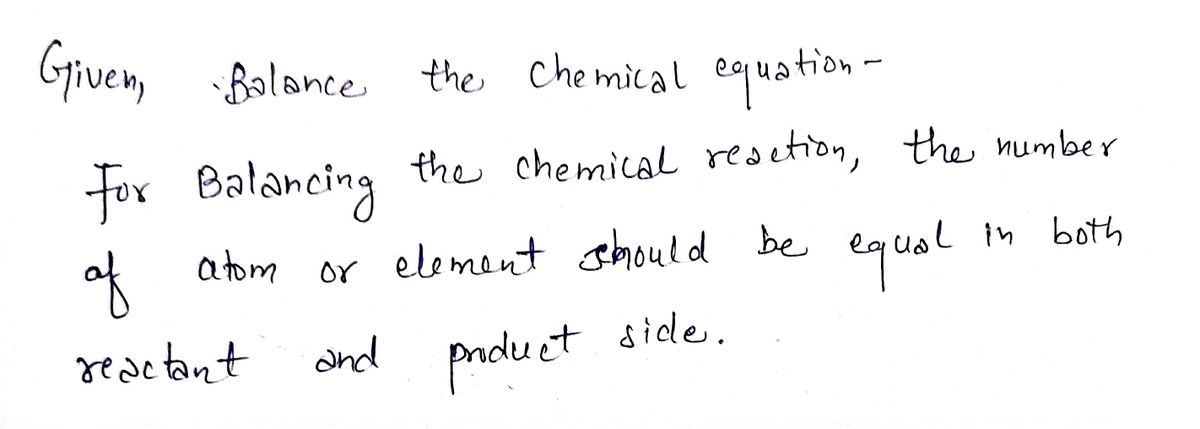< Question 13 of 20 Submit Write the balanced COMPLETE ionic equation for the reaction when aqueous CS3PO4 and aqueous AgNO3 are mixed in solution to form solid Ag3PO4 and aqueous CSNO3. If no reaction occurs, simply write only NR. Be sure to include the proper phases for all species within the reaction.
< Question 13 of 20 Submit Write the balanced COMPLETE ionic equation for the reaction when aqueous CS3PO4 and aqueous AgNO3 are mixed in solution to form solid Ag3PO4 and aqueous CSNO3. If no reaction occurs, simply write only NR. Be sure to include the proper phases for all species within the reaction.
Chemistry
10th Edition
ISBN:9781305957404
Author:Steven S. Zumdahl, Susan A. Zumdahl, Donald J. DeCoste
Publisher:Steven S. Zumdahl, Susan A. Zumdahl, Donald J. DeCoste
Chapter1: Chemical Foundations
Section: Chapter Questions
Problem 1RQ: Define and explain the differences between the following terms. a. law and theory b. theory and...
Related questions
Question

Transcribed Image Text:**Question 13 of 20**
**Balanced COMPLETE Ionic Equation Task**
Write the balanced COMPLETE ionic equation for the reaction when aqueous Cs₃PO₄ and aqueous AgNO₃ are mixed in solution to form solid Ag₃PO₄ and aqueous CsNO₃. If no reaction occurs, simply write only "NR." Be sure to include the proper phases for all species within the reaction.
**Instructions:**
1. Utilize the on-screen keypad to input ions and formulas.
2. Ensure to specify the state of each compound (solid (s), liquid (l), gas (g), aqueous (aq)).
**Additional Features:**
- Use buttons for ions and elements like Cs, P, Ag, and N.
- "Reset" button to clear current input.
- Arrow buttons for navigation.
**Note:** Tap for resources to explore more about chemical equations and reactions.
Expert Solution
Step 1: Concept

Step by step
Solved in 3 steps with 3 images

Knowledge Booster
Learn more about
Need a deep-dive on the concept behind this application? Look no further. Learn more about this topic, chemistry and related others by exploring similar questions and additional content below.Recommended textbooks for you

Chemistry
Chemistry
ISBN:
9781305957404
Author:
Steven S. Zumdahl, Susan A. Zumdahl, Donald J. DeCoste
Publisher:
Cengage Learning

Chemistry
Chemistry
ISBN:
9781259911156
Author:
Raymond Chang Dr., Jason Overby Professor
Publisher:
McGraw-Hill Education

Principles of Instrumental Analysis
Chemistry
ISBN:
9781305577213
Author:
Douglas A. Skoog, F. James Holler, Stanley R. Crouch
Publisher:
Cengage Learning

Chemistry
Chemistry
ISBN:
9781305957404
Author:
Steven S. Zumdahl, Susan A. Zumdahl, Donald J. DeCoste
Publisher:
Cengage Learning

Chemistry
Chemistry
ISBN:
9781259911156
Author:
Raymond Chang Dr., Jason Overby Professor
Publisher:
McGraw-Hill Education

Principles of Instrumental Analysis
Chemistry
ISBN:
9781305577213
Author:
Douglas A. Skoog, F. James Holler, Stanley R. Crouch
Publisher:
Cengage Learning

Organic Chemistry
Chemistry
ISBN:
9780078021558
Author:
Janice Gorzynski Smith Dr.
Publisher:
McGraw-Hill Education

Chemistry: Principles and Reactions
Chemistry
ISBN:
9781305079373
Author:
William L. Masterton, Cecile N. Hurley
Publisher:
Cengage Learning

Elementary Principles of Chemical Processes, Bind…
Chemistry
ISBN:
9781118431221
Author:
Richard M. Felder, Ronald W. Rousseau, Lisa G. Bullard
Publisher:
WILEY